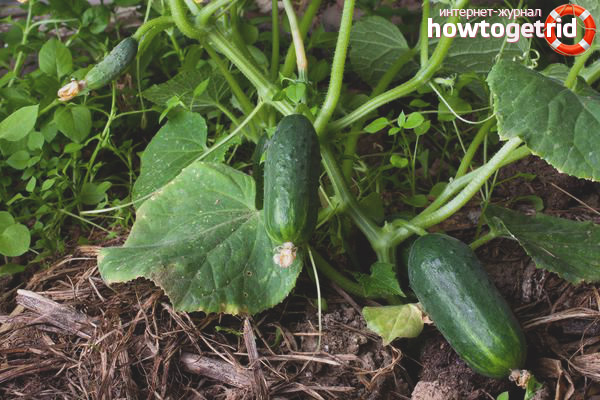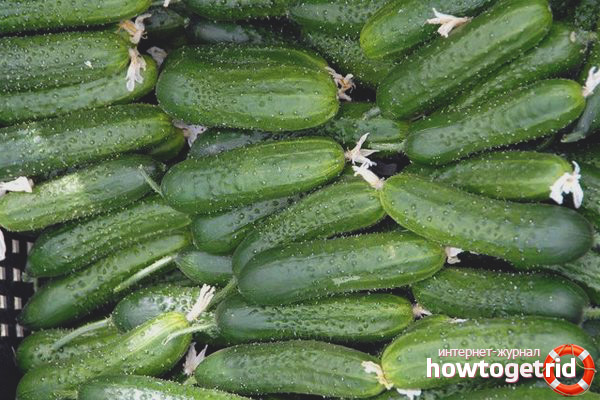The content of the article
Varieties of cucumbers with early ripening are always in demand among gardeners. After winter, everyone wants to quickly try fresh vegetables. The Zanachka variety is popular among vegetable growers; it is appreciated not only for early harvesting, but also for its high yield and good resistance to diseases. The variety is intended for cultivation in open beds and in greenhouse constructions of various types.
Grade description
The variety of cucumbers Zanachka belongs to the hybrid group. Plants are pollinated by bees. The fruiting period begins approximately 38-44 days after the appearance of the first seedlings. The shape of the fruit is oval, resembles a cylinder. The length of one cucumber reaches 10-12 cm. The average weight of one fruit is in the range of 110-130 grams. The surface of the skin is strewn with small tubercles with white spikes. In one sinus, up to 3 fruits appear.
From one square meter, you can collect from 10 to 12 kg of high-quality cucumbers with excellent taste characteristics. The fruits are great for fresh consumption and for canning according to different recipes.
Advantages and disadvantages of the variety
Cucumbers are grown in closed ground and in open beds not so long ago. During cultivation, the variety has gained many admirers who express unambiguous opinions. Gardeners note such advantages of the Zanachka variety:
- High yield even under adverse growing conditions.
- Excellent resistance to common fungal diseases.
- Excellent taste, genetic lack of bitterness in the pulp.
- The possibility of long-term storage and suitability for transportation over long distances without loss of commercial appearance.
- The versatility of vegetable culture.
- Easy care, no specific knowledge and skills required.
The disadvantages of the variety include the fact that seeds should always be purchased at the store, since hybrids do not transmit hereditary traits. Also, the formation of fruit ovaries requires the intervention of bees.
Cultivation agricultural
Cucumbers can be grown immediately with seeds in the ground or pre-grown seedlings. For planting seedlings, a suitable soil, container and seed are prepared. Seeds do not need additional processing, as manufacturers have already taken care of this. Soil can be used ready-made, purchased in a specialized store, and you can also cook it yourself. To do this, take garden soil and mix it with peat and river sand. The prepared mixture must be disinfected to destroy the larvae of pests and fungal viruses. To do this, it must be warmed up in the microwave or in the oven, processing with a weak manganese solution is suitable.
Sowing of seeds is carried out in late April or early May. The container is covered with a film on top and placed in a warm sunny place. You need to plant seedlings in a permanent place when 2-3 leaves are formed on the seedlings. Wells should be located at a distance of 40 cm from each other, between the rows of free space also leave 40 cm.
When planting seeds, they are laid to a depth of not more than 4 cm. The soil must be fertilized. You can make humus or chicken droppings in the fall. Cucumbers are planted in a well-lit area. When applying complex fertilizers as plants grow and develop, the dosage should be remembered. If you overfeed the plants, then this can adversely affect their full development.
Care Rules

The entire summer season must be carefully monitored for soil moisture. Cucumbers are a moisture-loving vegetable crop. At the first time after planting, it is necessary to begin regular irrigation with warm, well-maintained water. The procedure is recommended in the evening or in the morning. If the summer is hot and dry, you need to water it daily. For cucumbers, the drip method is preferable. So water will not get on the foliage of the plants, and the roots will receive the necessary moisture.
Be sure to loosen the soil after watering so that the surface of the earth is not covered with a crust. Also, loosening will help to balance the air exchange in the root system. Until the lashes have grown, weed must be constantly removed. Weeds take nutrients from the soil and are carriers of dangerous fungal viruses.
The nest egg variety needs the introduction of complex nutritional mixtures as it grows and develops. If cold weather conditions caused the yellowed leaves of the bushes, then you should prepare a solution of nitrogen fertilizer, and treat them with bushes.
The variety of cucumbers Zanachka enjoys well-deserved respect, both among ordinary summer residents and farmers who grow vegetables on an industrial scale. Unpretentiousness to climatic conditions and high resistance to diseases do this grade quite demanded. Reviews gardeners have only positive characteristics.
Reviews gardeners
- Valery Yurievich, 62 years old: I have been cultivating Zanachka cucumbers for 3 years now. Care for the variety is simple. I do not tie the scourges, I do not regularly fertilize, but I water them well. The harvest is always wonderful. I’m constantly making blanks. Pickled cucumbers are as crispy as fresh. The collection of the first cucumbers begins early. Of all the varieties, I prefer to grow these cucumbers. I want to recommend everyone to pay attention to this variety.
- Valentina G., 56 years old: The daughter advised to plant cucumbers of the Zanachka variety. They do not contain bitterness at all. Cucumbers have dense flesh with crunch. Bushes grow well, fruiting is friendly. It is very convenient when preparing preservation. Care of the variety is simple, watering often. A great advantage is the resistance of plants to various diseases.
Video: F1 Zanachka cucumbers










Submit